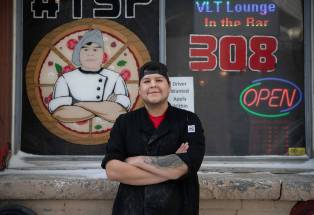Exhilarating heights, joyful falls Broken fingernails, scraped knuckles notwithstanding, wall-climbing proves a thrilling diversion to lift spirits, bypass urge to climb the pandemic’s isolating, closed-in walls
Read this article for free:
or
Already have an account? Log in here »
To continue reading, please subscribe:
Monthly Digital Subscription
$0 for the first 4 weeks*
- Enjoy unlimited reading on winnipegfreepress.com
- Read the E-Edition, our digital replica newspaper
- Access News Break, our award-winning app
- Play interactive puzzles
*No charge for 4 weeks then price increases to the regular rate of $19.00 plus GST every four weeks. Offer available to new and qualified returning subscribers only. Cancel any time.
Monthly Digital Subscription
$4.75/week*
- Enjoy unlimited reading on winnipegfreepress.com
- Read the E-Edition, our digital replica newspaper
- Access News Break, our award-winning app
- Play interactive puzzles
*Billed as $19 plus GST every four weeks. Cancel any time.
To continue reading, please subscribe:
Add Free Press access to your Brandon Sun subscription for only an additional
$1 for the first 4 weeks*
*Your next subscription payment will increase by $1.00 and you will be charged $16.99 plus GST for four weeks. After four weeks, your payment will increase to $23.99 plus GST every four weeks.
Read unlimited articles for free today:
or
Already have an account? Log in here »
Hey there, time traveller!
This article was published 04/02/2022 (1405 days ago), so information in it may no longer be current.
There’s a kid clambering up the wall, and he’s flying, because there is always a kid on the wall who is flying, because kids are lighter and bendier and they haven’t yet developed a real fear of death. They don’t seem so afraid of falling. They reach to the next spot without wondering how the stretch might wrench a lingering pain into their shoulders, their backs, their necks.
I watch the kid as he flies up the wall, toes pointed as he launches to catch a thin polyurethane wedge, covering a metre or more of empty vertical space in an instant. His fingers catch the wedge, then he taps his other hand to it, thus finishing the route he’d begun. It’s a hard one, so difficult I can’t even contort myself enough to get off the ground.
The kid dangles for a minute, letting his legs sway in the air. Then he lets go and falls more than three metres to the mat, landing the way he was taught, which has now become second-nature: feet first, knees slightly bent, rolling backwards to disperse the impact’s momentum through his buttocks and hips and up along the curve of his spine.
There’s no hope for nice nails when you spend two nights a week clawing your way up the textured surface of a steep indoor wall.
He stands up and scampers off, ready to try another route up the wall. Beside me, my friend shakes his head.
“Freaking kids,” he says, and we laugh, because we’re both a little impressed.
I look down at my hands, turning them over, noting where the weeping red of new scrapes on my knuckles thatches over the raised scabs of the old. I look at the spots on my palms where bits of skin are tearing off, as the cells underneath begin to knit themselves into a thicker callus. I look at my nails, torn and ragged, and sigh.
For most of my life, I was a chronic nail-biter. By 2020, I’d managed to conquer the habit, and began to take pride in keeping up a nice manicure. But in just the seven weeks since I started climbing, that’s been lost. There’s no hope for nice nails when you spend two nights a week clawing your way up the textured surface of a steep indoor wall.
It’s worth it, though. Climbing was a bucket-list item of mine, which seems strange to say given that it’s an accessible activity with a few popular local gyms — The Hive, Vertical Adventures, a climbing wall at the University of Manitoba — and a global surge in popularity, thanks to the Olympics and sensational documentaries such as The Dawn Wall and Free Solo.
Still, when I’d sat down and written out list of 100 dreams I hoped to achieve, climbing was one.
The first time I tried it last February, I moved slowly up the wall. I’d grip a secure hold with each hand and then I clung, too scared to go up and too scared to come down, trying to calculate the likelihood I’d be able to reach the next hold. This was during the time gyms could open only for one-on-one instruction; below me, a coach shouted encouragement.
When I tried again, I moved quicker. I stopped listening to the voices in my head that knew the next hold was too thin, or too smooth, or too far.
After I made my way down, she sat with me for a while while I rested. She asked if I’d ever climbed when I was little. Oh yeah, I told her. I thought about the big cottonwood tree that spread across our front yard. I remembered how I’d wedge myself into the crotch where its three biggest limbs met, and then clambering out onto its arms. The coach nodded.
“You have to climb like kids do,” she said, and suddenly, climbing made sense.
When I tried again, I moved quicker. I stopped listening to the voices in my head that knew the next hold was too thin, or too smooth, or too far. I pushed up with my legs and swivelled out with my hips and reached with as much energy as I could, and sometimes I made it, but I stopped being afraid of what would happen if I didn’t. I learned how to fall.
And in December, when I started climbing in earnest, finding at the bouldering gym a release from Omicron’s stillness, the lesson the coach taught me lingered. I saw how the kids flew up the wall with a freedom, a joy in their movement. I vowed I would stop believing so much in my own limits. I remember the wrinkled skin of the cottonwood under my fingers.
I am not a good climber. Maybe I never will be. But each time I go, I see improvements. Suspended by my fingers, about three metres off the ground, I step up on a slope that once terrified me, and realize I’m still safe; I swing to the side, toes skipping along the wall, and touch both hands to the route’s final hold. I let out a shocked laugh in elation.
We don’t get enough of that, I think. Not enough moments where everyone around you is happy for you, because they know you did something you couldn’t do before.
Below, I hear people cheering: “Awesome, Melissa, you did it!” I don’t know how they all know my name; I only met most of them in the minutes between climbing. And what I’ve just done is an easy route, one they do for a warmup, but by the sound of their voices I know how much they wanted this moment for me, how much they were willing me up the wall.
We don’t get enough of that, I think. Not enough moments where everyone around you is happy for you, because they know you did something you couldn’t do before, even if it’s something simple, even if it’s very small. I started climbing because it scared me, a little; I stay because in the moments where doubts crack my mind, the voices from below keep me whole.
As the weeks turn, all I can think about is climbing. I watch YouTube videos and follow climbers on Instagram and soak up techniques I’m not yet ready to try. “Come climbing,” I text to all my friends. I’ve become one of those people who tries to sell everyone they know on the new thing they love. But they come, and they try and then they love it, too.
I start to notice things, about the first-timers. I notice how most of them try to haul themselves up the wall by strength alone, arms and backs straining. I realize that I was like that, too. I know what to tell them now: climbing isn’t about brute force. You don’t have to push it. You just have to move and see what happens. You have to let yourself go.
“My problem is, I’m scared of heights,” they say.
Yeah, I reply, me too. But it’s not really the heights, so much as the falling. You’re scared of falling. You’re scared of what will happen to you if you let go, that split-second in the air, unmoored, with gravity in control. But you know how to fall now, you got a lesson when you came in. You know the mats will catch you, and that it won’t hurt at all.
That’s the thing climbing taught me. If you want to go higher, then you have to embrace the fall.
melissa.martin@freepress.mb.ca
Our newsroom depends on a growing audience of readers to power our journalism. If you are not a paid reader, please consider becoming a subscriber.
Our newsroom depends on its audience of readers to power our journalism. Thank you for your support.











